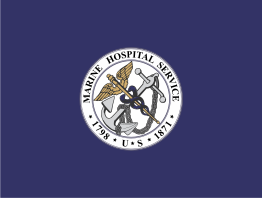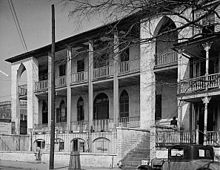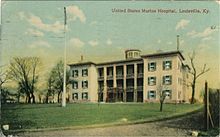Marine Hospital Service
 From Wikipedia - Reading time: 13 min
From Wikipedia - Reading time: 13 min

The Marine Hospital Service was an organization of Marine Hospitals dedicated to the care of ill and disabled seamen in the United States Merchant Marine, the U.S. Coast Guard and other federal beneficiaries. The Marine Hospital Service evolved into the U.S. Public Health Service.
It was the point of origin for several components of the current Public Health Service, including the Public Health Service Commissioned Corps, the National Institutes of Health, and multiple programs now incorporated into the Health Resources and Services Administration.
History
[edit]Background: Marine Hospital Fund
[edit]
The origins of the system of Marine Hospitals can be traced to the passage, by the 5th Congress of the United States, of "An Act for the Relief of Sick and Disabled Seamen" in 1798. This act created Marine Hospitals to care for sick seamen.[1][2] The Marine Hospital Fund was placed under the Revenue Marine Service (a forerunner of the present-day Coast Guard) within the Department of the Treasury.[3]
It was the first federal health law.[2] It authorized a tax, which was the deduction of twenty cents per month from the wages of the seamen.[4] This tax raised funds for physicians and to support the network of hospitals.[5] Funding for the hospitals was provided by a mandatory tax of about 1% of the wages of all maritime sailors.[1][6] (In 1884, the tax was abolished and in 1906 funds were dispensed by Congress.)
The act led to the gradual creation of a network of hospitals along coastal and inland waterways.[7] They were initially located along the East Coast, at the harbors of the major port cities, with Boston being the site of the first such facility, followed later by others including in the Baltimore vicinity at Curtis Bay.[1][2] As the boundaries of the United States expanded, and harbors were built on other coasts, so too were marine hospitals. In the 1830s and 1840s they were built along inland waterways, the Great Lakes, and the Gulf of Mexico. After the acquisition of the Oregon Territory (1846) and California (1848) hospitals were built in 1850s at Pacific Coast harbors.[1]
Following the Civil War, public outcry and scandal surrounded the Marine Hospital Fund. In 1869, Dr. John Shaw Billings, a prominent Army surgeon, was appointed to head an investigation of the Marine Hospital Fund. Dr. Billings found the hospital fund to be inadequate and completely disorganized.
Establishment
[edit]In June 1870 the 41st Congress formally converted the loose network of locally controlled marine hospitals, the Marine Hospital Fund, into a centrally controlled Marine Hospital Service, with its headquarters in Washington, D.C. This reorganization made the Marine Hospital Service into its own bureau within the Department of the Treasury.[3]
Dr. John Maynard Woodworth was subsequently appointed to the Service as "Supervising Surgeon." He transformed the service into a disciplined organization based on his experience in the Union Army as a surgeon. Dr. Woodworth required his physicians to be a mobile work force stationed where the service was in need, and he mandated the daily wear uniforms. This eventually led to the creation of the modern-day Public Health Service Commissioned Corps. Dr. Woodworth, using Army-style heraldry, created the Marine Hospital Service fouled anchor and caduceus seal which is used to this day by the Public Health Service. In 1873, Dr. Woodworth's title was changed to "Supervising Surgeon General," a forerunner of the modern-day office of Surgeon General of the United States.[8]
Woodworth created a cadre of mobile, career service physicians, who could be assigned as needed to the various Marine Hospitals. The commissioned officer corps was established by legislation in 1889, and signed by President Grover Cleveland. At first open only to physicians, over the course of the 20th century, the Corps expanded to include veterinarians, dentists, physician assistants, sanitary engineers, pharmacists, nurses, environmental health officers, scientists, and other types of health professionals. It is now known as the Commissioned Corps of the U.S. Public Health Service.
Increasing scope
[edit]The scope of activities of the Marine Hospital Service began to expand well beyond the care of merchant seamen in the closing decades of the nineteenth century, beginning with the control of infectious disease. Starting in the mid-14th century, ships entering harbors were quarantined when any of the crew was sick. This practice was normal procedure at United States harbors, with quarantine originally a function of the individual states, rather than of the Federal Government. The National Quarantine Act of 1878 vested quarantine authority to the Marine Hospital Service. However, the Public Health Act of 1879 created the National Board of Health, through which quarantine authority was shared with the U.S. Army and Navy; this arrangement was not reauthorized by Congress in 1883, and its powers reverted solely to the Marine Hospital Service.[9] Over the next half a century, the Marine Hospital Service increasingly took over quarantine functions from individual state authorities.

The Marine Hospitals, as their name suggests, were hospitals constructed at key sea and river ports across the nation to provide health care for merchant marine sailors. Aside from the well-being of these sailors, the hospitals provided a key monitoring and gate-keeping function against pathogenic diseases.[3] As immigration increased dramatically in the late 19th century, the Federal Government also took over the processing of immigrants from the individual states, beginning in 1891. The Marine Hospital Service was assigned the responsibility for the medical inspection of arriving immigrants at sites such as Ellis Island in New York Harbor. Commissioned officers played a major role in fulfilling the Service's commitment to prevent disease from entering the country.
As the nation grew, the scope of Marine Hospital Service's duties grew to include domestic and foreign quarantine and other national public health functions. Over time, the hospitals of the service were also expanded to include research and prevention work as well as the care of patients. Aside from merchant seamen, members of the military, immigrants, Native Americans, other federal beneficiaries, and people affected by chronic and epidemic diseases found a source for health care in the MHS and its hospitals.[citation needed]
In 1899, the Marine Hospital Service first formed internal divisions: the Division of Marine Hospitals and Relief, Division of Domestic (Interstate) Quarantine, Division of Insular and Foreign Quarantine and Immigration, Division of Personnel and Accounts, Division of Sanitary Reports and Statistics, Division of Scientific Research and Sanitation, and Miscellaneous Division, although there were minor name changes after this time.[10]
Transformation into Public Health Service
[edit]
In 1902, the Marine Hospital Service was renamed the "Public Health and Marine-Hospital Service." In 1912, as the emphasis of its responsibilities shifted from sailors to general public health, the name was changed again to the "Public Health Service" to encompass its diverse and changing mission.

The Division of Hospitals, which contained the Marine Hospital system, became part of the Bureau of Medical Services in 1943, and was eventually renamed as a different Bureau of Medical Services within the Health Services Administration in 1973.[10][11] Large new buildings were constructed for many Marine Hospitals in the 1920s and 1930s, and the system reached its peak of 30 hospitals in 1943.[12] A wave of closings in 1944–1953 mainly targeted hospitals that had not been upgraded, and another wave during 1965–1970 closed the remaining hospitals at inland locations, leaving eight general hospitals and the National Leprosarium operating.[13] The system was abolished in 1981, with the last eight general hospitals transferred to other organizations,[14][15] and the remaining functions of the Bureau of Medical Services merged into the present Bureau of Primary Health Care within the Health Resources and Services Administration (HRSA).[16][17] PHS would however continue to operate the National Leprosarium until 1999.[18]
Other pre-1912 divisions of the Marine Hospital Service have descendants that operate to the present day:
- The Division of Domestic Quarantine became the Division of States Relations and then the Bureau of State Services in 1943.[10] This bureau would eventually give rise to the modern Centers for Disease Control and Prevention (CDC), as well as the HRSA Bureau of Health Workforce and Healthcare Systems Bureau.[10][19]
- The Division of Scientific Research became the National Institutes of Health. The Environmental Health Divisions (predecessor of the Environmental Protection Agency and FDA Center for Devices and Radiological Health), and the Division of Industrial Hygiene (predecessor of the National Institute for Occupational Safety and Health), were spun off from it in the mid-20th century.[10][20][21]
- The Division of Foreign Quarantine eventually became the CDC Division of Global Migration and Quarantine.[22][23]
- The Division of Sanitary Reports and Statistics was an ancestor of the CDC National Center for Health Statistics.[10]
Today, the records for these institutions sit in storage at the National Library of Medicine in Bethesda, Maryland and the National Archives in College Park, Maryland.[citation needed]
Hospitals
[edit]The hospitals themselves were, by the middle of the 19th century, fairly imposing and architecturally grand structures in many cases. As long as ample federal funding was available for their construction, these hospitals were impressive examples of government-provided health care. The hospitals of the early 20th century in major port cities such as New Orleans, San Francisco, and Savannah displayed ornate architectural detail and reflected many of the changes sweeping medicine at the time.[citation needed]
In addition to the major hospitals, many lower-class hospitals and clinics existed.[10][24]
A chronological gallery of hospitals constructed prior to 1912 follow, showing the year operations began as a U.S. Marine Hospitals. Not all hospitals are shown. Structures that are still extant are marked with an asterisk (*).
-
Temporary Boston hospital at Castle Island, 1800
-
Norfolk, Virginia hospital, 1800
-
Second Boston hospital at Charlestown Navy Yard, 1804
-
Fourth Boston hospital in Chelsea, Massachusetts, 1827
-
Mobile, Alabama hospital, 1843*
-
Lahaina, Hawaii hospital, 1844*
-
Key West, Florida hospital, 1845*
-
First New Orleans hospital at Algiers, 1847
-
Natchez, Mississippi hospital, 1852
-
Cleveland hospital, 1852
-
First Chicago hospital at Fort Dearborn, 1852
-
First San Francisco hospital at Rincon Point, 1854
-
Fifth Boston hospital in Chelsea, Massachusetts, 1857*
-
Detroit hospital, 1857
-
St. Louis hospital, 1858
-
Portland, Maine hospital, 1859*
-
First Cincinnati hospital, 1860
-
Second New Orleans hospital, never completed, abandoned 1860
-
Galena, Illinois hospital, 1861*
-
Second Chicago hospital, 1873
-
Second San Francisco hospital at the Presidio, 1875
-
Second Cincinnati hospital in the former Kilgour Mansion, 1882
-
Third New Orleans hospital, 1883
-
Port Townsend, Washington hospital, 1883
-
Memphis, Tennessee hospital, 1884*
-
Cairo, Illinois hospital, 1886
-
Baltimore hospital, 1887*
-
Evansville, Indiana hospital, 1892
-
Tuberculosis sanatorium at Fort Stanton, New Mexico, 1898*
-
Second Wilmington, North Carolina hospital, 1898
-
Savannah, Georgia hospital, 1906*
-
Second Pittsburgh hospital, 1909*
-
Buffalo, New York hospital, 1909*

See also
[edit]- Timeline of the United States Public Health Service Commissioned Corps
- United States Public Health Service
References
[edit]- ^ a b c d Gostin, Lawrence O. (2008). "Box 8: The Federal Presence in Public Health". Public Health Law: Power, Duty, Restraint, Revised and Expanded (2nd ed.). University of California Press. p. 156. ISBN 978-0520253766. Retrieved November 8, 2012.
- ^ a b c "Public Health". marinehospital.org. Retrieved March 7, 2018.
- ^ a b c "Images From the History of the Public Health Service: Introduction". nlm.nih.gov. Retrieved December 3, 2017.
- ^ "Justice Network - Sick and Disabled Seaman Act of 1798 Govt. Healthcare". nosue.org. Retrieved March 7, 2018.
- ^ "Public Health in the United States". sphweb.bumc.bu.edu. Retrieved March 7, 2018.
- ^ Ungar, Rick (January 17, 2011). "Congress Passes Socialized Medicine and Mandates Health Insurance -In 1798". Forbes.com. Retrieved November 8, 2012.
- ^ "About the Commissioned Corps". usphs.gov. Archived from the original on July 28, 2007. Retrieved March 7, 2018.
- ^ ASPA. "John Maynard Woodworth (1871-1879)". surgeongeneral.gov. Archived from the original on December 1, 2017. Retrieved December 3, 2017.
- ^ Smillie, W. G. "The National Board of Health, 1879-1883" American Journal of Public Health and The Nation's Health (1943) 33(8):925-930.
- ^ a b c d e f g "Records of the Public Health Service [PHS], 1912-1968". National Archives. August 15, 2016. Sections 90.3, 90.7, 90.8. Retrieved August 28, 2020.
- ^ "Reorganization and functions of the Public Health Service". United States Senate. 1943. pp. 4–6. Retrieved September 15, 2020 – via Internet Archive. Alt URL
- ^ Public Health Service Hospital Closings. U.S. House of Representatives. 1965. p. 3.
- ^ "United States. Public Health Service. Division of Hospitals". SNAC. Retrieved August 31, 2020.
- ^ Driscoll, Robert S. (February 1, 1986). "What Happened to the U.S. Public Health Service Hospital?". Military Medicine. 151 (2): 128–129. doi:10.1093/milmed/151.2.128. ISSN 0026-4075. PMID 3083292.
- ^ "United States. Public Health Service. Division of Hospitals". SNAC. Retrieved August 31, 2020.
- ^ 47 FR 38409
- ^ Erickson, Anna. "A Policy History of the Community Health Centers Program: 1965-2012" (PDF). University of Michigan. Retrieved August 30, 2020.
- ^ "History of the National Hansen's Disease (Leprosy) Program". HHS-Health Resources and Services Administration. Retrieved July 27, 2011.
- ^ "Records of the Health Resources and Services Administration [HRSA]". National Archives. August 15, 2016. Section 512.2. Retrieved August 29, 2020.
- ^ "Records of the Environmental Protection Agency [EPA]". National Archives. August 15, 2016. Section 412.2. Retrieved August 29, 2020.
- ^ Doyle, Henry N. (1977). "The federal industrial hygiene agency: a history of the Division of Occupational Health, United States Public Health Service" (PDF). American Conference of Governmental Industrial Hygienists. Retrieved September 3, 2020.
- ^ "Images From the History of the Public Health Service: Disease Control and Prevention, Fighting the Spread of Epidemic Diseases". U.S. National Library of Medicine. January 16, 2012. Retrieved September 16, 2020.
- ^ "History of Quarantine". U.S. Centers for Disease Control and Prevention. July 20, 2020. Retrieved September 21, 2020.
- ^ Annual Report of the Surgeon General of the Public Health Service of the United States. U.S. Government Printing Office. 1921. p. 301.
External links
[edit]- The National Library of Medicine has a guide to the documents culled from various PHS hospitals when these closed.
- marinehospital.org- Website of the U.S. Hospital Foundation, which is restoring the Marine Hospital in Louisville, Kentucky.
- History Of National Institution Of Health
 KSF
KSF





































